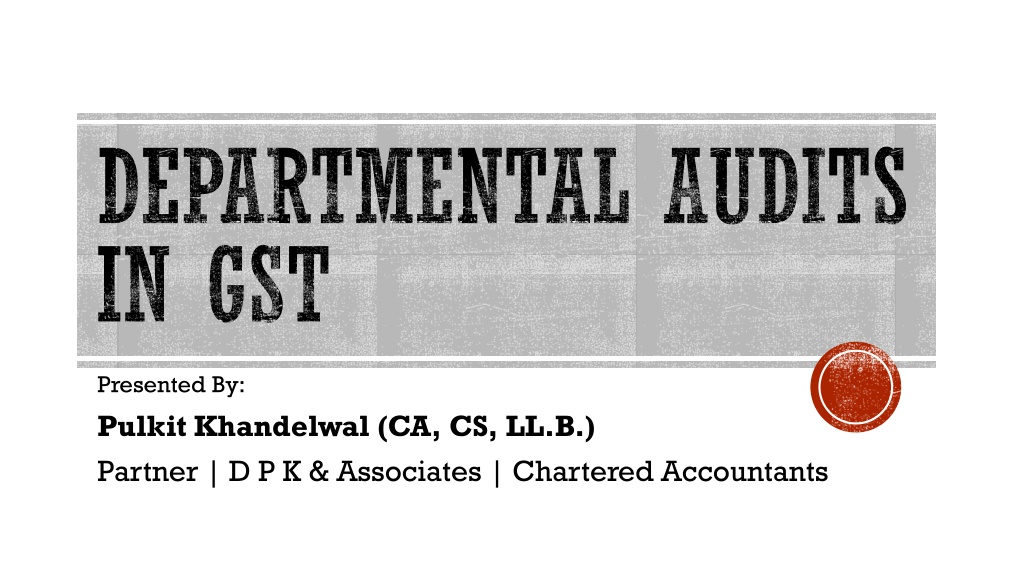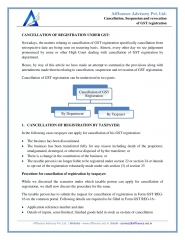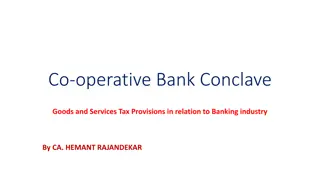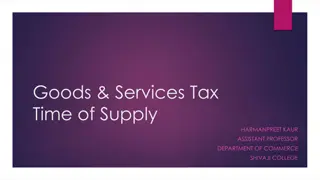Understanding Departmental Audits in GST
Departmental audits in GST involve the examination of records, returns, and other documents to verify the correctness of turnover declared, taxes paid, refunds claimed, and input tax credit availed. This audit ensures compliance with the provisions of the CGST Act, 2017. Types of audits under GST include Audit by Professionals (GSTR-9C), Departmental Audit (under Section 65 of the Act), and Special Audit (under Section 66 of the Act). Tax authorities have the power to conduct audits at the place of business of registered persons. The audit must be completed within a specified timeframe, with the possibility of extension under certain circumstances.
Download Presentation

Please find below an Image/Link to download the presentation.
The content on the website is provided AS IS for your information and personal use only. It may not be sold, licensed, or shared on other websites without obtaining consent from the author. Download presentation by click this link. If you encounter any issues during the download, it is possible that the publisher has removed the file from their server.
E N D
Presentation Transcript
DEPARTMENTAL AUDITS IN GST Presented By: Pulkit Khandelwal (CA, CS, LL.B.) Partner | D P K & Associates | Chartered Accountants
GST THE JOURNEY SO FAR A complex indirect tax structure Various unresolved mysteries Continuous updates & amendments in law & procedures Conflicting decisions of AAR Issues in ITC CA. Pulkit Khandelwal
MEANING OF AUDIT Section 2(13) of the CGST Act, 2017, defines Audit as: theexamination of records, returns and other documents maintained or furnished by the registered person under this Act or Rules made thereunder or under any other law for the time being in force to verify, inter alia, the correctness of turnover declared, taxes paid, refund claimed and input tax credit availed, and to assess his compliance with the provisions of this Act or rules made thereunder CA. Pulkit Khandelwal
MEANING OF AUDIT Examination of: records, returns and other documents maintained or furnished by the registered person To verify the correctness of: turnover declared, taxes paid, refund claimed and input tax credit availed, and to assess his compliance CA. Pulkit Khandelwal
TYPES OF AUDIT UNDER GST Type 1: Audit by Professionals (GSTR-9C) now foregone Type 2: Departmental Audit (under Section 65 of the Act) [similar to Business Audit] Type 3: Special Audit (under Section 66 of the Act) [conducted by professional like CA] CA. Pulkit Khandelwal
SECTION 65. AUDIT BY TAX AUTHORITIES (1) The Commissioner or any officer authorised by him, by way of a general or a specific order, may undertake audit of any registered person for such period, at such frequency and in such manner as may be prescribed. (2) The officers referred to in sub-section (1) may conduct audit at the place of business of the registered person or in their office. (3) The registered person shall be informed by way of a notice not less than fifteen working days prior to the conduct of audit in such manner as may be prescribed (4) The audit under sub-section (1) shall be completed within a period of three months from the date of commencement of the audit: Provided that where the Commissioner is satisfied that audit in respect of such registered person cannot be completed within three months, he may, for the reasons to be recorded in writing, extend the period by a further period not exceeding six months. Explanation. For the purposes of this sub-section, the expression commencement of audit shall mean the date on which the records and other documents, called for by the tax authorities, are made available by the registered person or the actual institution of audit at the place of business, whichever is later. CA. Pulkit Khandelwal
SECTION 65. AUDIT BY TAX AUTHORITIES (5) During the course of audit, the authorised officer may require the registered person, (i) to afford him the necessary facility to verify the books of account or other documents as he may require; (ii) to furnish such information as he may require and render assistance for timely completion of the audit. (6) On conclusion of audit, the proper officer shall, within thirty days, inform the registered person, whose records are audited, about the findings, his rights and obligations and the reasons for such findings. (7) Where the audit conducted under sub-section (1) results in detection of tax not paid or short paid or erroneously refunded, or input tax credit wrongly availed or utilized, the proper officer may initiate action under section 73 or section 74 CA. Pulkit Khandelwal
SECTION 65. AUDIT BY TAX AUTHORITIES Order general or specific Auditee only RP Period FY or part thereof or Multiples thereof (Rule 101) subject to limitation period prescribed under Sec 73/74 At POB of RP or at their office (desk audit) Prior notice of 15 days (atleast) before audit is conducted To be completed within 3 months from commencement Date of commencement of audit refer explanation to Sec 65 Extension of 6 months by the Commissioner CA. Pulkit Khandelwal
SECTION 65. AUDIT BY TAX AUTHORITIES Duties of taxpayer: Provide facility to verify BOA & other docs Provide other assistance as required Findings of audit to be informed within 30 days of conclusion of audit Actions may be initiated under Sec 73 / 74 of the Act on the basis of audit results CA. Pulkit Khandelwal
SECTION 71. ACCESS TO BUSINESS PREMISES. (1) Any officer under this Act, authorised by the proper officer not below the rank of Joint Commissioner, shall have access to any place of business of a registered person to inspect books of account, documents, computers, computer programs, computer software whether installed in a computer or otherwise and such other things as he may require and which may be available at such place, for the purposes of carrying out any audit, scrutiny, verification and checks as may be necessary to safeguard the interest of revenue. (2) Every person in charge of place referred to in sub-section (1) shall, on demand, make available to the officer authorised under sub-section (1) or the audit party deputed by the proper officer or a cost accountant or chartered accountant nominated under section 66 (i) such records as prepared or maintained by the registered person and declared to the proper officer in such manner as may be prescribed; (ii) trial balance or its equivalent; (iii) statements of annual financial accounts, duly audited, wherever required; (iv) cost audit report, if any, under section 148 of the Companies Act, 2013; (v) the income-tax audit report, if any, under section 44AB of the Income-tax Act, 1961; and (vi) any other relevant record, for the scrutiny by the officer or audit party or the chartered accountant or cost accountant within a period not exceeding fifteen working days from the day when such demand is made, or such further period as may be allowed by the said officer or the audit party or the chartered accountant or cost accountant. CA. Pulkit Khandelwal
RULE 101. AUDIT.- (1) The period of audit to be conducted under sub-section (1) of section 65 shall be a financial year [or part thereof] or multiples thereof. (2) Where it is decided to undertake the audit of a registered person in accordance with the provisions of section 65 , the proper officer shall issue a notice in FORM GST ADT-01 in accordance with the provisions of sub-section (3) of the said section. (3) The proper officer authorised to conduct audit of the records and the books of account of the registered person shall, with the assistance of the team of officers and officials accompanying him, verify the documents on the basis of which the books of account are maintained and the returns and statements furnished under the provisions of the Act and the rules made there under, the correctness of the turnover, exemptions and deductions claimed, the rate of tax applied in respect of the supply of goods or services or both, the input tax credit availed and utilised, refund claimed, and other relevant issues and record the observations in his audit notes. CA. Pulkit Khandelwal
RULE 101. AUDIT.- (4) The proper officer may inform the registered person of the discrepancies noticed, if any, as observed in the audit and the said person may file his reply and the proper officer shall finalise the findings of the audit after due consideration of the reply furnished. (5) On conclusion of the audit, the proper officer shall inform the findings of audit to the registered person in accordance with the provisions of sub-section (6) of section 65 in FORMGST ADT-02. CA. Pulkit Khandelwal
SAMPLE RISK PARAMETERS FOR SELECTION OF CASES FOR AUDIT Volume of the Taxpayer s turnover/net profit, If any changes happened in the Taxpayer s turnover/net profit for the previous years, Volume of Exemptions claimed by the taxpayer s year wise, Higher incidence of supplies without issuance of E-Way Bills Taxpayer who does not file periodical return but issues E-Way Bills and inconsistency in the data declared in GSTR-1 and E-way Bills generated, Financial ratio analysis and if any major variations observations , Volume of Tax Refund claimed by the taxpayer s year wise comparison and if any variations observations, Multitude of the taxpayer s legal relationships with other entities, Taxpayer has multiple branches, CA. Pulkit Khandelwal
SAMPLE RISK PARAMETERS FOR SELECTION OF CASES FOR AUDIT Taxpayer who has requested waiver or is bankrupt, Taxpayer categorized as High Risk, Taxpayer s return was previously investigated for evasion, Taxpayer who has not been audited in the pre-GST era for a long period i.e. 4 to 5 years under VAT or Service Tax, Any specific information received from other Government authorities i.e. Income Tax, ROC,RBI, Local tax authorities or any written compliant received from the person. Difference in the turnover as declared in Form GSTR-1 and GSTR-3B returns for continuous period, Difference in ITC availed and utilized as per GSTR-3B and ITC available as per GSTR-2A, Wrong classification of goods or services provide, effecting wrong levy of tax, Mismatch in the details of Export reported under GSTR-1 and information lodged on ICEGATE, CA. Pulkit Khandelwal
VERIFICATION OF RECORDS BY AUDIT TEAM AND AUDIT NOTES: (i) Books of accounts as per Section 35 of the CGST Act read with Rule 56 Prescribes Accounts and record requirements for a registered person, (ii) Tax Invoices, Bill of Supply, Delivery Challans, Credit Notes, Debit Notes, receipt Vouchers, payment vouchers and refund etc., (iii) If the taxpayer is having multiple branches, stock transfers amongst branches must also be reconciled. Stock Register reflecting opening balance, receipts, supply and goods lost, stole Destroyed and the closing stock, (iv) If the taxpayer is a manufacturer, production records including break up of raw Materials, finished goods, scrap, etc., (v) Details of Advances received and paid during the audit period, CA. Pulkit Khandelwal
VERIFICATION OF RECORDS BY AUDIT TEAM AND AUDIT NOTES: (vi) Records pertaining to Input Tax Credit availed and utilized like if the taxpayer claimed extra ITC , he will have to pay interest @24% on the excess tax amount ,the auditor would need to reconcile that businessman does not claim excess Input Tax Credit. Input Tax Credit should be reversed for non-payment within 180 days and this should be checked by the auditor, (vii) If the taxpayer has maintained electronic records, log of all the entries modified or Deleted etc., (viii).If the taxpayer is a Job worker, Job work register etc., Was there any good which was sent on approval basis and it s exceeding the time limit of 6 months and not offered to tax? If yes, then add that amount in turnover and increase the tax liability (ix) Details of E-Way Bills register as per GSTN data, (x) Copies of GST Returns like GSTR-1, GSTR-2A,GSTR-2B, GSTR-3B, GSTR-4,GSTR 5,GSTR-5A, GSTR-6, GSTR 9/9C, GSTR-10, ITC-01, ITC-05, ITC-05A and RFD-01 and copies of tax payment challan etc., for the audit periods. CA. Pulkit Khandelwal
VERIFICATION OF RECORDS BY AUDIT TEAM AND AUDIT NOTES: (xi) Audited financial Statements including Audit Report etc., for the audit periods, (xii) Copy of Income Tax Return(filed) for the audit periods, (xiii) Copy of Form 26AS provided by I.T. Department for the audit periods. (xiv) Copies of Inward and Outward Ledgers, (xv) Copy of the GST registration certificates of Principal Place of Business and branch and other place of details whether incorporated or not, (xvi) Ledger of stock maintained at where house by the taxable person, (xvii) Copy and details of Trans-1, Trans-2 and 2A and Trans-3 etc., for the year 2017-18 along with stock register and copies of original invoice relating to ITC claimed in Trans-1 for the period prior to July 2017 as per Sec.143 of CGST Act,2017. CA. Pulkit Khandelwal
VERIFICATION OF RECORDS BY AUDIT TEAM AND AUDIT NOTES: Director s Report: important happenings like fire and loss of material in the company, details of new products launched, change in the marketing pattern etc. reported in the report may be useful to the auditor. Auditor s Report: Auditor may report that goods meant for outward supply, available in stock were not reconciled or provision for obsolete items have not been made during the year CARO - whether the fixed assets records have been maintained properly or whether physical verification of inward supplies and goods meant for outward supply was undertaken and whether any discrepancies were noticed on such verification or whether the company has maintained proper records for unserviceable or damaged goods. CARO also shows disputed tax liabilities separately for Customs, Income Tax, GST etc. Cases booked under Income Tax may be examined to find out any implication on GST. CA. Pulkit Khandelwal
VERIFICATION OF RECORDS BY AUDIT TEAM AND AUDIT NOTES: Profit & Loss Account Scrutiny of supplies Other incomes like scrap, insurance claims receipt, profit on sale of fixed assets, commission received, erection and commissioning, freight and insurance recovered etc. value of inward supplies on which GST is payable under Reverse Charge - Section 9(3) Balance Sheet Study of schedule of Share Capital may reveal if the company is subsidiary company and in case the company is holding company, in that case, the name of subsidiary company will be disclosed in the Schedule of Investment. If there are supplies between holding company and subsidiary & vice versa, valuation aspects needs to be examined in the light of CGST Rules. additions and deductions to the fixed assets during the year. For the deductions made during the year, verification may be made as to whether appropriate GST has been paid. CA. Pulkit Khandelwal
VERIFICATION OF RECORDS BY AUDIT TEAM AND AUDIT NOTES: Notes to the Accounts accounting policy in the areas like revenue recognition or determination of obsolete stock Cases of use of inputs for other purposes (not in the course of business or furtherance of business) may also be noticed from the study of such information. Adjustment for shortages, losses etc. may also be reported in the said information Related party transactions Trial Balance Accounts which have a prima facie relevance for GST payment or availment of ITC Unusual ledger accounts like Loss of inputs or unusual income accounts may also be noticed in the Trial Balance Various income accounts (credit balances) available in the Trial Balance like Job Work Income Account, Erection and Commissioning Income Account, Commission Account, Recovery of Freight/Advertisement Charges Account Technical Consultation Income Account etc. CA. Pulkit Khandelwal
VERIFICATION OF RECORDS BY AUDIT TEAM AND AUDIT NOTES: Scrutiny of the Tax Audit Report Clause 18 of the Tax Audit Report provides information about amount of depreciation under Section 32 of the Income Tax Act, 1961 and that of ITC availed on capital goods. Clause 27(a) of the Tax Audit report gives the details of ITC claimed. It also provides the details of credit available and carried forward to the next year. Hence, the Auditor can authenticate the amount of credit carried forward in the GST returns with the information provided in terms of this clause. Clause 21(b) of the Tax Audit Report also gives information regarding prior period incomes and expenses booked in the year under Tax audit. The Auditor may check that GST on such supplies is paid on these amounts as per the provisions of Time of supply under CGST Act. Clause 38 of the Tax Audit Report provides the information relating to Cost Audit. Clause 40 of the Tax Audit Report provides the important accounting ratios CA. Pulkit Khandelwal
COMMON DEPARTMENTAL ISSUES ITC GSTR 3B vs 2A / 2B Data of GSTR 1 vs GSTR 3B Late Fees Interest on late payment Gross Vs Net RCM issues 9(3), 9(4) CA. Pulkit Khandelwal
INPUT TAX CREDIT - ISSUES Section 16 Conditions for ITC admissibility: Possession of tax invoice or debit note Invoice details communicated to recipient (w.e.f. 01.01.2022) Receipt of goods or services Not restricted under Section 38 (w.e.f. 01.10.2022) Tax has been paid to the government Return furnished under Sec 39 CA. Pulkit Khandelwal
LITIGATION TRENDS GST Audits & Assessments Show Cause Notices issued Demand Orders raised System generated demands Orders of First Appellate Authority GST Tribunal Writ Petition CA. Pulkit Khandelwal
DISCUSSIONS: Time period prior to conduct the audit:- The proper officer after receiving intimation and authorization from the Commissioner about GST Audit under Sec.65 of CGST Act, 2017, where it is decided to undertake the audit of a registered person, shall issue a notice not less than 15 working days prior to the conduct of Audit , Time Limit for completion of Audit by the GST department:- The GST Audit officer is required to complete within 3 months from the date of commencement of audit. The period can be extended for a further period of a maximum of 6 months by the Commissioner, CA. Pulkit Khandelwal
DISCUSSIONS: Relevant comparisons to be done by audit officers: Reconciliation between taxable value and tax liability declared in GSTR 3B and GSTR 1. 2. Reconciliation between Input Tax Credit claimed in GSTR 3B and that reflected in GSTR 2A/2B 3. Reconciliation of Tax liability declared and ITC Claimed in GSTR 3B with books of accounts. 4. Reconciliation of Taxable value as per GSTR 9C/9 with that in the Trial Balance. CA. Pulkit Khandelwal
THANK YOU!! Pulkit Khandelwal (CA, CS, LL.B.) Certified in GST & NPOs by ICAI Partner | D P K & Associates | Chartered Accountants E: capulkitkhandelwal@gmail.com | M: +91-9783592230 O: 303. Third Floor, Soni Paris Point, Collectorate Circle, Jaipur-302016 Youtube: https://www.youtube.com/channel/UC4NKr_wkaAWRZFBcJ2Lts2g LinkedIn: https://in.linkedin.com/in/pulkit-khandelwal-53b0b445 CA. Pulkit Khandelwal























